Home > software_development > Open Source Contribution and Compensation
Open Source Contribution and Compensation
Open-source development represents far more than just a way to write and share code. It embodies a powerful approach to building technology through collaboration.
By :Thomas Inyang🕒 19 May 2025
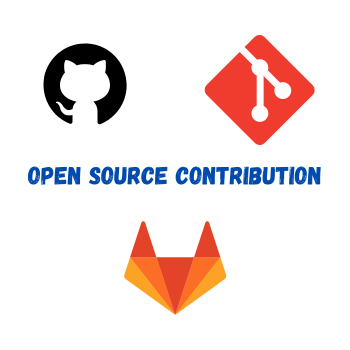
Introduction
Tech thrives on collaboration, and open-source development has proven to be the driving force. GitHub, the world's largest platform for code hosting and collaboration, stands at the epicenter of this movement, enabling millions of developers worldwide to create, share, and improve software together. Whether you're a coding novice or a seasoned professional, understanding how to effectively contribute to GitHub projects can significantly impact your technical skills, professional network, and career opportunities.
This article will walk you through what GitHub contributions really mean, how they work, and why they matter in today's tech landscape. Also, you will get to see the practical strategies for beginning your contribution journey, navigating the open-source ecosystem, and maximizing the visibility and impact of your work.
By the end of this article,
- You'll have a clear roadmap for meaningful participation in the global community of developers who are shaping the future of technology through collaboration.
- What is GitHub and Open Source Development?
- What Counts as a GitHub Contribution?
- How to Start Contributing on GitHub
- How to Find The Right Open Source Projects to Contribute To
- The Impact of Open Source Contribution and Compensation
Understanding GitHub and Open Source Contributions
What is GitHub and Open Source Development?
It is a web-based platform that uses Git to host code repositories, facilitating collaborative software development. Open source refers to software whose source code is publicly available for anyone to view, modify, and distribute under specific licensing terms.
GitHub has become the home for open-source projects, serving as both a technical infrastructure and a social network for developers. At its core, open-source development represents a philosophy of transparency and community-driven innovation, where code is shared freely and improved collectively.
Unlike proprietary software developed behind closed doors, open-source projects invite contributions from anyone interested in participating. This collaborative approach has led to the creation of some of the world's most important software, including Linux, WordPress, and countless libraries and frameworks that power modern applications.
See Also: Web Development Is Not As Difficult as You Think
When people talk about contributing to GitHub, they're typically referring to participating in these open-source projects by submitting code, documentation, or other improvements.
While GitHub hosts millions of open-source projects, the platform itself is now owned by Microsoft and is not fully open source. However, parts of GitHub's ecosystem, like their Atom text editor and numerous other tools, are available as open-source projects.
What Counts as a GitHub Contribution?
A GitHub contribution is any action that leaves a record on your GitHub profile, including commits, pull requests, issues, and code reviews. These activities are tracked and displayed on your profile's contribution graph, which then appears as green squares on your profile's contribution graph (often called the "contribution calendar" or, informally, "the green grid").
The following activities are officially counted as GitHub contributions:
- Commits to repositories (both personal and others)
- Pull requests opened for proposing changes
- Issues created to report bugs or request features
- Code reviews conducted on others' pull requests
- Discussion participation in repository discussions
- Repository creation and maintenance
For these activities to count toward your public contribution graph, they must meet certain criteria:
- The contribution must be made to a public repository (unless you've enabled private contribution display)
- The contribution must be linked to your GitHub account
- The contribution must be made on the default branch or in a GitHub Pages branch
It's worth noting that contributions to forked repositories only count if you've created a pull request that's been merged into the original project. Simply committing to your fork won't register on your public contribution graph until those changes are incorporated upstream.
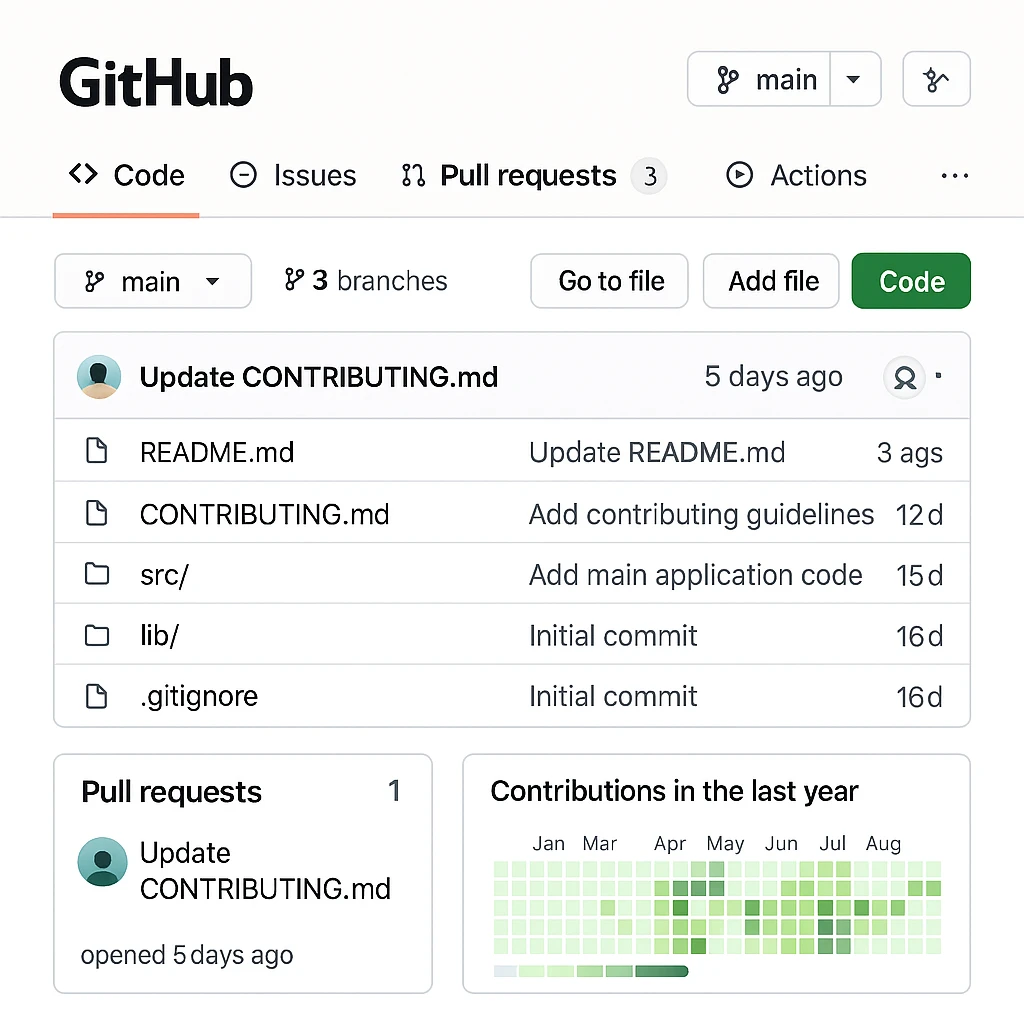
The Difference Between Git and GitHub
Git is a distributed version control system created by Linus Torvalds in 2005 that tracks changes in source code during software development, while GitHub is a cloud-based hosting service that leverages Git for version control and adds collaboration features like pull requests, issues, and project management tools.
Understanding the relationship between Git and GitHub is essential for any developer looking to contribute to open-source projects.
See Also: Quick Steps To Start Your Web Development Journey.
When you contribute to GitHub, you're using Git commands (like commit, push, and pull) to manage your code changes, but you're doing so within GitHub's ecosystem, which adds functionality like pull requests, issue tracking, and project boards.
The distinction becomes important when discussing alternatives. There are other Git-based platforms like GitLab and Bitbucket that offer similar services to GitHub but with different features and pricing models. All of them use Git as their foundation but build different experiences on top of it.
Getting Started with GitHub Contributions
How to Start Contributing on GitHub
Beginning your journey as a GitHub contributor involves creating an account, learning basic Git commands, finding suitable projects, understanding contribution guidelines, and submitting your first pull request. Here's a step-by-step guide to getting started:
- Create a GitHub account: Sign up at github.com with a professional username that you won't mind sharing with potential employers.
- Set up Git on your computer: Install Git locally and configure it with your GitHub credentials.
- Learn Git basics: Familiarize yourself with essential commands like clone, commit, push, pull, and branch.
- Understand GitHub workflow: Learn about repositories, forks, branches, and pull requests—the fundamental concepts that power collaboration on GitHub.
- Find beginner-friendly projects: Look for repositories labeled with tags like "good first issue," "beginner-friendly," or "help wanted."
- Read contribution guidelines. Most projects have a CONTRIBUTING.md file that outlines the process and expectations for contributors.
- Start small: Begin with documentation improvements, bug fixes, or small feature enhancements rather than tackling major changes.
- Fork and clone: Create a personal copy (fork) of the repository you want to contribute to, and then download it (clone) to your computer.
- Make changes and test: Implement your changes locally and ensure they work as expected before submitting them.
- Submit a pull request: Push your changes to your fork and create a pull request describing what you've done and why it's valuable.
Remember that contributing to GitHub isn't just about writing code. You can also make meaningful contributions by doing the following: reporting issues when you encounter bugs or have feature suggestions, improving documentation to help others understand the project better, reviewing pull requests from other contributors, and answering questions in discussions or issue threads.

How to Find The Right Open Source Projects to Contribute To
One of the biggest challenges for newcomers to open-source contribution is finding appropriate projects that match their skills and interests. Use GitHub's search and filtering tools, explore curated lists of beginner-friendly projects, and leverage community resources that connect contributors with projects.
Here are several effective approaches to discover projects where you can make meaningful contributions:
GitHub's Built-in Tools:
- Use GitHub's Explore feature to discover trending and recommended repositories
- Filter repositories by language, topic, or tags like "good-first-issue."
- Visit github.com/topics/[your-interest] to find projects in specific domains
- Check GitHub's "Trending" page for active projects gaining momentum
External Resources:
- First Timers Only (firsttimersonly.com) – Specifically designed to help newcomers find their first contribution opportunity
- Up For Grabs (up-for-grabs.net) – Curates projects with tasks specifically flagged for new contributors
- Good First Issue (goodfirstissue.dev) – Aggregates beginner-friendly issues across GitHub
- CodeTriage (codetriage.com) – Helps you subscribe to open source projects and receive new issues in your inbox
Strategic Approaches:
- Contribute to tools you already use: If you regularly use an open-source library or application, you'll have insight into improvements that could be valuable.
- Follow developers you admire, check what projects they're contributing to, and consider joining those communities.
- Join open-source communities; platforms like Discord servers, Slack workspaces, and forums related to open source can connect you with active projects.
When evaluating potential projects for your first GitHub contribution, consider these factors:
- Look at the activity level for repositories with recent commits and active maintainers
- Projects with clear documentation, codes of conduct, and responsive maintainers determines the community health
- A healthy project has a manageable number of open issues relative to contributors.
- Well-documented projects make it easier for newcomers to understand how to contribute
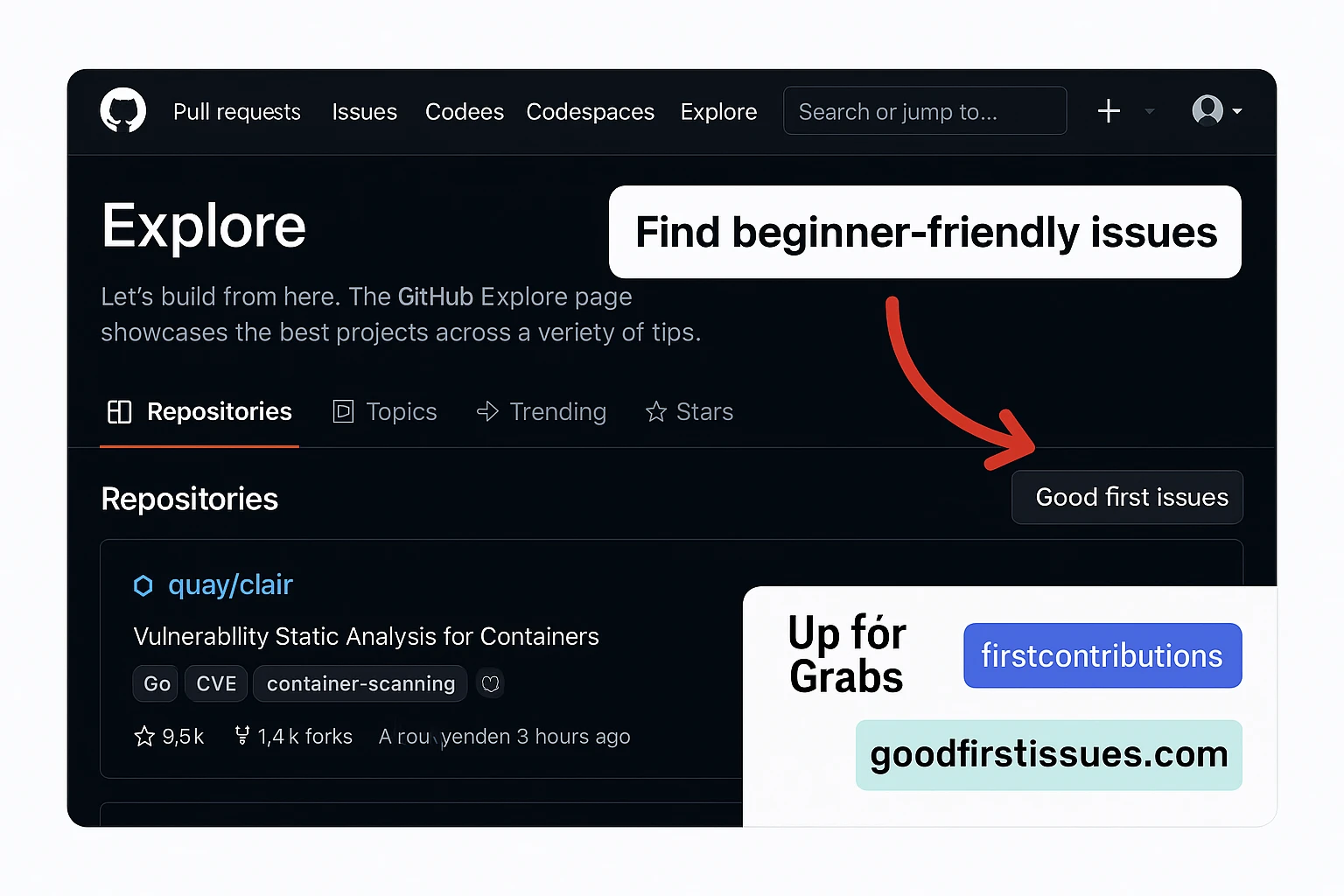
What Is GitHub Forking and Cloning of Repositories
Forking creates a personal copy of someone else's repository on your GitHub account, allowing you to freely experiment without affecting the original project. Cloning downloads a repository from GitHub to your local machine, enabling you to work on it offline.
These processes form the foundation of how you'll interact with repositories before making contributions.
Forking a repository can be done by clicking the "Fork" button at the top right of any GitHub, which creates your own copy of the project on GitHub under your account. This copy remains connected to the original (or "upstream") repository, allowing you to:
- Make changes without affecting the original project
- Submit contributions back to the original project via pull requests
- Keep your fork updated with changes from the original project
After forking, you'll need to get the code onto your local machine to work on it. This is where cloning comes in (git clone https://github.com/your-username/repository-name.git), and you will be able to do the following:
- Make changes to the code in your preferred development environment
- Test your changes locally before pushing them back to GitHub
- Commit your work incrementally with meaningful messages
Asking if you should fork or clone a repository is a common question among beginners. The answer depends on your intention:
- Fork first and clone someone else's project if you're contributing to it.
- If you're just using or studying the code, clone directly without forking
- If it's your repository, clone directly.
You can also fork your repository if you want to experiment with significant changes without affecting the main project. It creates a separate copy under your account that you can use for testing risky changes.
The Impact and Visibility of GitHub Contributions
Do GitHub Contributions Matter?
GitHub contributions serve as a public record of your development activity and collaboration skills, offering tangible evidence of your coding experience, technical interests, and community involvement. Here are some of the impacts of GitHub contribution:
Professional Impact: Contributions can demonstrate practical experience and technical skills to potential employers; a strong contribution history can build credibility with potential clients, and regular contributions show productivity and self-motivation.
Technical Growth: Working on diverse projects exposes you to different codebases and practices that can boost your personal growth. Having your code reviewed by experienced developers accelerates learning and feedback. Also, fixing bugs and implementing features builds practical problem-solving abilities.
Community Standing: Consistent, quality contributions can establish you as a trusted member of open-source communities. Collaboration often leads to connections with other professionals in your field. Contributing helps sustain the open-source ecosystem that many developers benefit from.
While contributions are valuable, it's important to maintain perspective. The contribution graph (the green squares showing activity) has limitations as a metric:
- Quantity doesn't equal quality—thoughtful, well-crafted contributions outweigh numerous minor ones
- The graph doesn't capture contributions to private repositories by default
- It doesn't reflect offline coding work, design thinking, or project planning
- Some developers make significant contributions through other channels (forums, documentation, mentoring)
Do Employers and Recruiters Look at GitHub Contributions?
Employers and recruiters often examine GitHub profiles to evaluate a candidate's practical coding experience, project involvement, coding style, collaboration skills, and technical interests beyond what's stated on a resume. This is different in reality.
How Recruiters Use GitHub:
- Some technical recruiters scan GitHub profiles to verify claimed skills, experience, code quality, and problem-solving approaches.
- Contribution patterns and interaction styles can indicate how you work with others and demonstrate genuine interest.
It's worth noting that employers typically understand the limitations of GitHub activity as an evaluation metric. Most recognize that:
- Many excellent developers contribute primarily to private repositories
- Work and family responsibilities may limit contribution time
- Contribution gaps don't necessarily indicate lack of coding activity
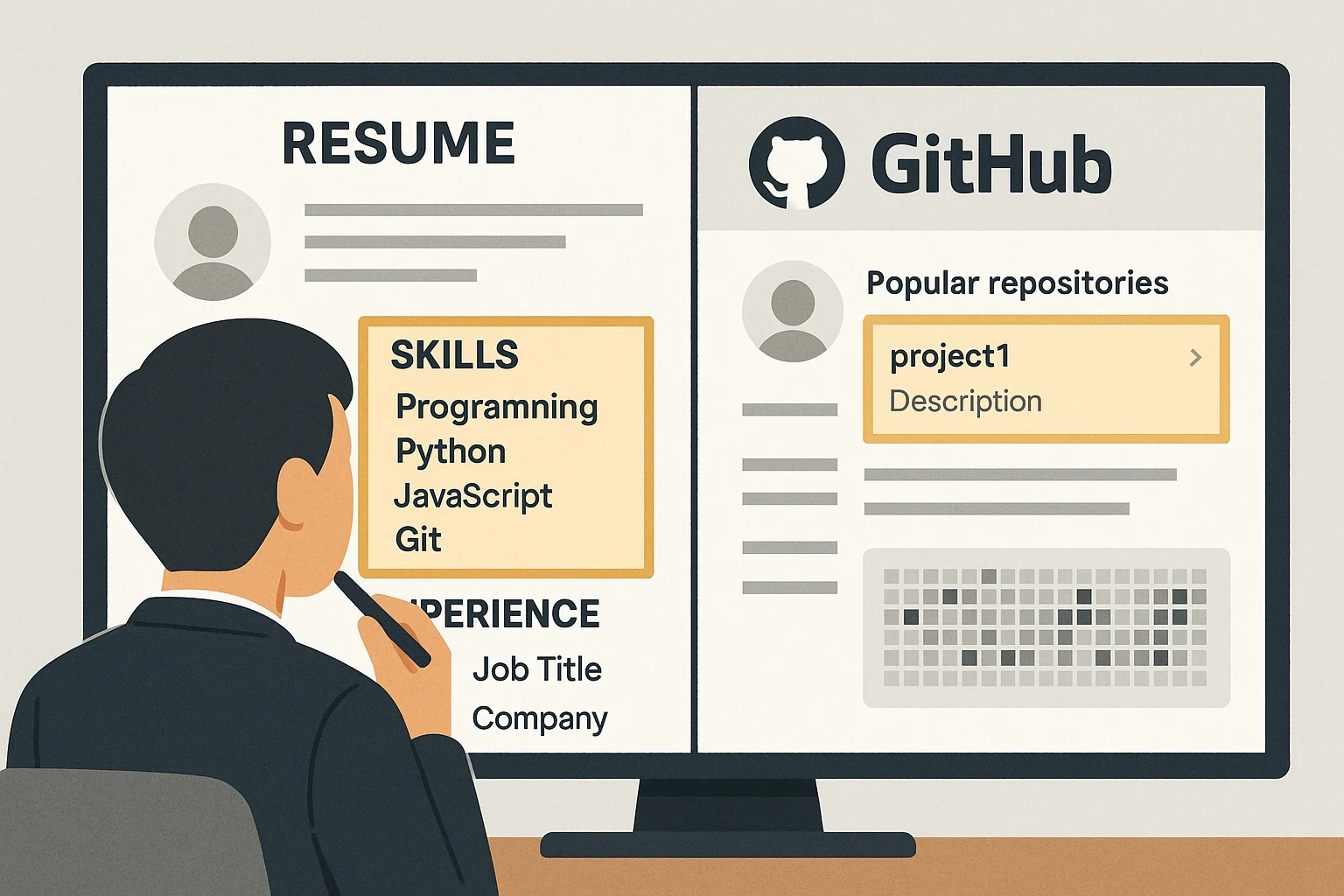
How to Showcase Open Source Contributions on Your Resume
This involves strategically highlighting your GitHub projects, contributions to other repositories, and the skills and technologies you've demonstrated through your open-source work. This approach can significantly enhance your job prospects by providing concrete evidence of your skills. Here's how to go about it:
Create a specific section on your resume titled "Open Source Contributions" or "Open Source Projects." Within this section:
- List significant projects you've contributed to or maintain
- Briefly describe your role and contributions
- Highlight notable outcomes or impact (e.g., "Reduced load time by 30%")
- Include links to repositories or merged pull requests for verification
OPEN SOURCE CONTRIBUTIONS
React.js Community (github.com/facebook/react)
- Contributed performance optimizations reducing bundle size by 4%
- Fixed accessibility issues in documentation examples
- Implemented test coverage for edge cases in useEffect hook.
If your open-source work was substantial or done during employment gaps, you can treat it as professional experience.
WORK EXPERIENCE
Open Source Developer (Self-directed) Jan 2022–Present
- Maintain a data visualization library with 2,000+ GitHub stars
- Collaborated with international team of 15 contributors
- Implemented CI/CD pipeline, reducing deployment time by 60%
Use your contributions to reinforce technical skills claims.
TECHNICAL SKILLS
JavaScript (Advanced): Implemented complex state management in React projects
Git/GitHub (Expert): Managed 200+ pull requests as an open source maintainer
Remember that open-source contributions count as work experience in many cases, especially when:
- The work demonstrates relevant technical skills
- You've maintained consistent involvement over time
- Your contributions show initiative and self-direction
- You've collaborated effectively with others
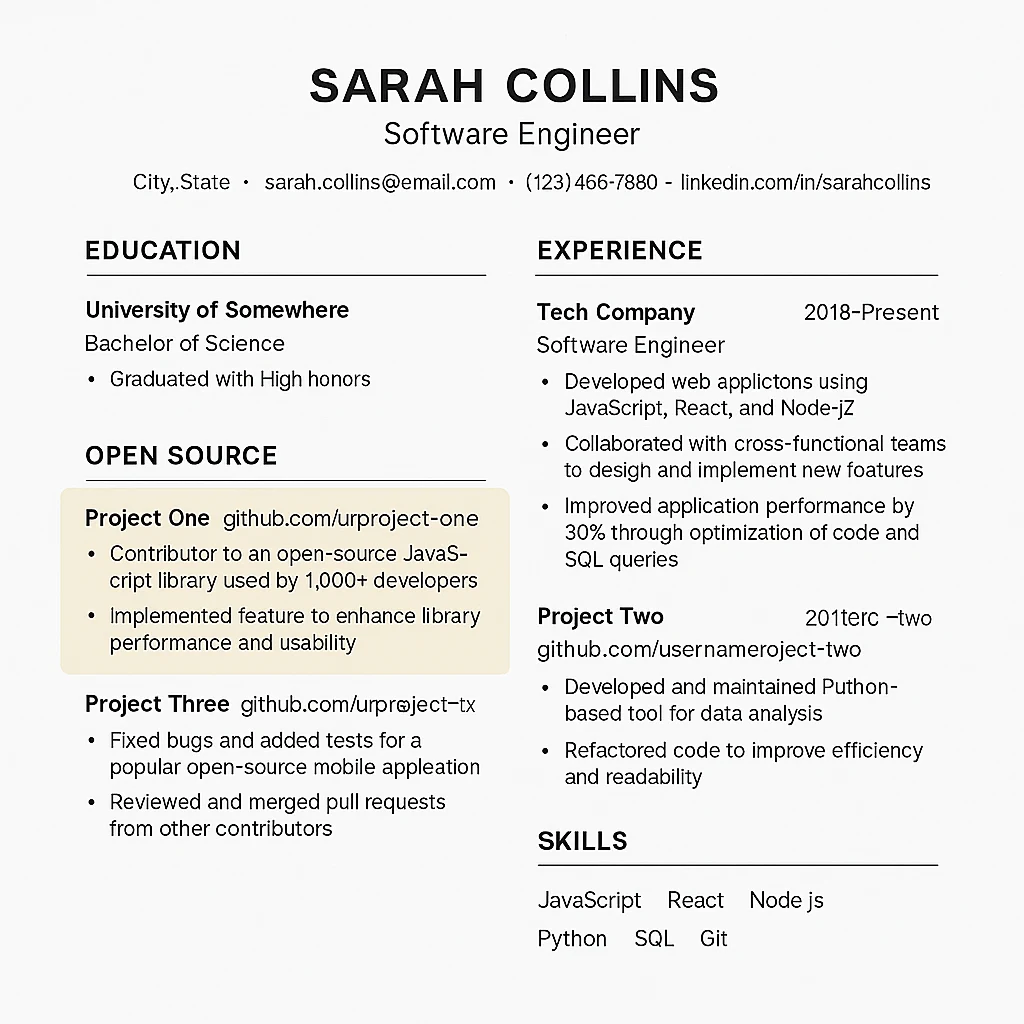
How to Manage the Visibility of Your GitHub Contributions
This involves controlling which contributions appear on your public profile, including options to show or hide contributions to private repositories, make specific repositories private, or selectively showcase pinned repositories. Irrespective of these, GitHub offers several visibility options:
Private Contributions Display: By default, only contributions to public repositories appear on your profile. To change this:
- Go to your GitHub profile
- Click "Settings"
- Select "Profile" from the sidebar
- Scroll to "Contributions & Activity"
- Check or uncheck "Include private contributions on my profile"
This setting allows you to make GitHub contributions private or include them in your public contribution graph without revealing the specific private repositories you're working on.
Repository Privacy Controls: To control the visibility of entire repositories:
- Navigate to the repository
- Click "Settings"
- Scroll to "Danger Zone"
- Find "Change repository visibility"
- Select "Make private" or "Make public"
Note that making a repository private will remove its contributions from your public graph unless you've enabled the private contributions display option mentioned above.
Strategic Profile Curation: Beyond basic visibility settings, you can strategically highlight your best work:
- Pinned repositories: Select up to six repositories to feature prominently on your profile page
- Profile README: Create a special repository named after your username to display customized content at the top of your profile
- Repository topics: Add relevant topics to your repositories to make them more discoverable
- Detailed descriptions: Write informative repository descriptions and READMEs to provide context for your work
The Economics of Open Source Contribution
Do GitHub Contributors Get Paid?
Most GitHub contributors participate voluntarily without direct compensation, though some earn income through sponsorships, bounties, employment at companies that support open-source projects, consulting opportunities, or maintenance contracts for popular repositories.
Direct Compensation Models:
- GitHub's built-in sponsorship program allows users to financially support contributors
- Platform for transparent fundraising and spending for open source communities
- Services like BountySource or IssueHunt where contributors are paid for solving specific issues
- Organizations like Mozilla, Google, and the Linux Foundation offer grants for open source work
- Companies hiring maintainers to work on projects they depend on
Indirect Economic Benefits:
- Visible contributions often lead to better job, professional, consulting, or speaking opportunities.
- Working on diverse projects builds marketable expertise.
While most contributors start as volunteers, pathways to compensation do exist. According to GitHub's 2021 Open Source Survey, approximately 11% of contributors receive some form of direct financial compensation for their open source work, with that percentage growing steadily.
How Open Source Contributors Make Money
They generate income through multiple channels, including corporate sponsorship, consulting services, employment at companies using their projects, paid support and training, crowdfunding and donations, and bounty programs for specific features or bug fixes.
Employment-Based Models:
- Corporate open source development: Companies like Red Hat, Microsoft, and Google employ developers specifically to work on open source projects
- Internal usage experts: Businesses hire contributors to help implement and customize the open source technologies they use
- Developer advocacy: Companies hire known contributors to represent their platforms and tools
Service-Based Models:
- Consulting: Providing expert implementation and customization services
- Support contracts: Offering guaranteed response times and troubleshooting
- Training and education: Teaching others how to use the technology
- Certification programs: Verifying expertise in specific open source technologies
Product-Based Models:
- Open core: Offering a free open source version with paid premium features
- Hosted services: Providing managed instances of the open source software (like MongoDB Atlas)
- Dual licensing: Using restrictive licenses for commercial use and open licenses for non-commercial use
Community-Based Models:
- GitHub Sponsors: Monthly sponsorship from users who value your contributions
- Open Collective: Pooled funding from multiple sponsors with transparent allocation
- Patreon/Ko-fi: Subscription-based support from fans and users
- Bounties: One-time payments for implementing specific features or fixing bugs
Growing Your Impact as a GitHub Contributor
This involves steadily increasing the significance and visibility of your contributions through strategic project selection, relationship building with maintainers, consistent participation, and gradually taking on more complex challenges.
While focusing solely on increasing the number of green squares on your contribution graph isn't the most meaningful approach, there are strategies to grow both the quantity and quality of your contributions:
Strategic Contribution Approaches:
- Contribution consistency: Regular, smaller contributions often have more impact than sporadic large ones
- Project selection: Contributing to widely-used projects increases the visibility and impact of your work
- Documentation improvements: Often overlooked but highly valuable contributions that can help you learn a project
- Issue triage: Helping maintain issue quality by confirming bugs, requesting more information, or identifying duplicates
- Code review: Providing thoughtful feedback on others' pull requests builds reputation and knowledge
Technical Growth Path: As you gain experience, progress through these stages:
- Documentation fixes: Correct errors, improve clarity, add examples
- Minor bug fixes: Address simple issues with clear solutions
- Feature enhancements: Add small new capabilities or improvements
- Major features: Design and implement significant new functionality
- Architecture work: Contribute to core system design and structure
Building Maintainer Relationships: The path to becoming a trusted contributor involves:
- Following project guidelines meticulously
- Responding promptly and professionally to feedback
- Helping with unglamorous but necessary tasks
- Demonstrating long-term commitment to the project
- Supporting other contributors and fostering community
Making Your GitHub Profile More Appealing:
- Complete your profile. Add a professional photo, bio, and contact information
- Pin strategic repositories: Highlight your best work at the top of your profile
- Create a profile README: Showcase your skills and interests with helpful documentation
- Use a consistent coding style. Demonstrate professionalism through attention to detail
Conclusion
The world of GitHub contributions and open-source development represents far more than just a way to write and share code. It embodies a powerful approach to building technology through collaboration, offering benefits that extend from individual developers to global industries and societies.
Throughout this guide, we've explored the mechanics of how to contribute, the strategic considerations around where and what to contribute, and the various ways these contributions can impact your career and the broader tech ecosystem. We've seen that while most contributors start as volunteers, there are increasingly viable pathways to making open source work financially sustainable.
Whether you're a student looking to build experience, a professional aiming to expand your skills, or an organization considering how to engage with open-source communities, the fundamental principles remain the same: contribute value, respect community norms, build relationships through quality work, and maintain a long-term perspective.
As you begin or continue your journey in open-source contribution, remember that every meaningful project started with small steps. Your first pull request might seem minor, but it represents the beginning of what could become a transformative professional and technical journey. The community welcomes contributors at all skill levels who approach participation with humility, curiosity, and a genuine desire to improve the digital tools we all rely on.
The future of technology depends on collaborative innovation. By becoming an active GitHub contributor, you're not just improving your skills and career prospects—you're participating in one of the most significant technological and social movements of our time.
Please Share